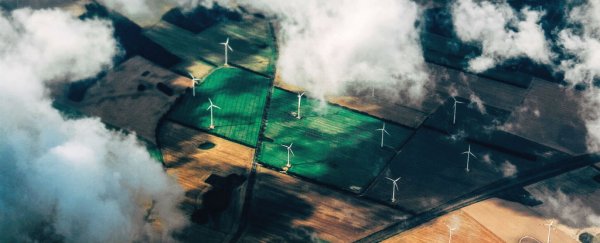A new study has found that up to a third of the power demands of the eastern side of the US could be met by renewables within a decade.
This is big news, and not just for those concerned about the environment. The Eastern Interconnection (EI) power grid that serves more than 240 million in the Eastern US has been clunking along for more than a century, and experts are urging that major updates be considered.
The National Renewable Energy Laboratory (NREL) in Colorado has been investigating if the possibility of adding renewables to the EI grid is technically viable, and their findings have just been published in the Eastern Renewable Generation Integration Study (ERGIS).
They found that the sprawling, complex network of the EI grid - which stretches from the middle of Canada to the tip of Florida, and includes 5,600 generators, 50,000 nodes, and 60,000 transmission lines - could take up to 30 percent of its energy from variable sources, like solar and wind, even if they don't provide the same level of input around the clock.
"By modelling the power system in depth and detail, NREL has helped reset the conversation about how far we can go operationally with wind and solar in one of the largest power systems in the world," said one of the researchers, Charlton Clark, from the US Department of Energy.
The NREL used some high-performance computing platforms and custom-made visualisations to figure out just how much varied, renewable energy the EI could take. The US Department of Energy's liquid-cooled Peregrine supercomputer was tasked with most of the number-crunching.
Millions of calculations were made at 5-minute intervals to simulate the performance of the EI as demand went up and down, and as energy input increased and decreased. You can watch a summary of the results below:
The hope is that the new data can help system operators, regulators, and the US government to understand the kinds of changes that will be needed to reach that 30 percent level - because while infrastructure changes will be required, it's all possible with current technology.
"The EI can accommodate lots of renewables, quickly," Daniel Roberts reports for Vox. "Specifically, it can accommodate 30 percent 'variable generation' (VG) - on- and offshore wind, utility and distributed solar - by 2026, using tools available today. It will require space, money, and transmission lines, but no new advances in energy storage or demand management."
Traditional coal and gas power stations will have to get better at increasing output as required, to make up for times when renewable sources aren't producing as much energy, such as sunrise and sunset.
Improvements will also be needed in ways that can't be modelled on a computer. For example, regional operators are going to have to cooperate more closely with each other, and new government incentives will be required to change how energy is provided.
But the bottom line of the new study is this: it can be done by 2026, even with 60,000 transmission lines to consider. And if they get it right, then there's the potential to exceed that 30 percent figure in the future.
